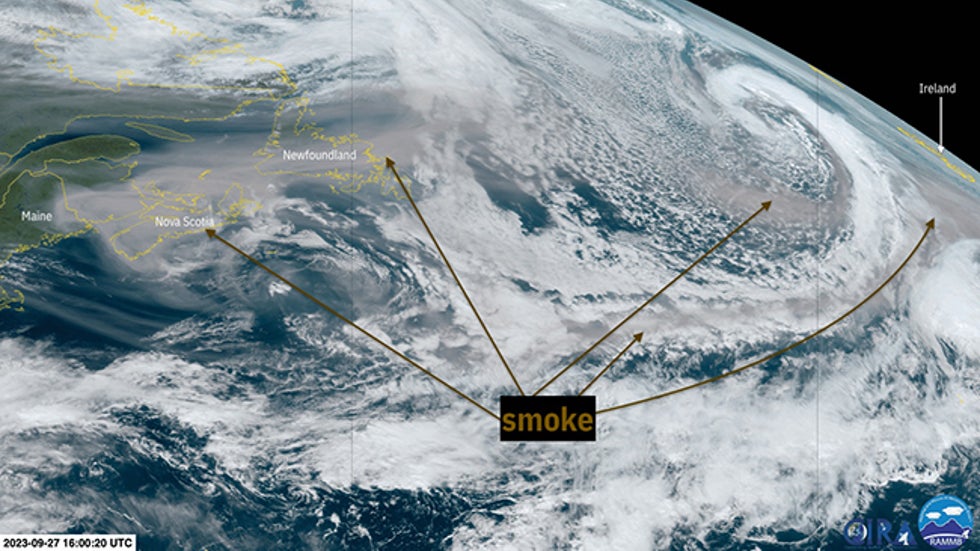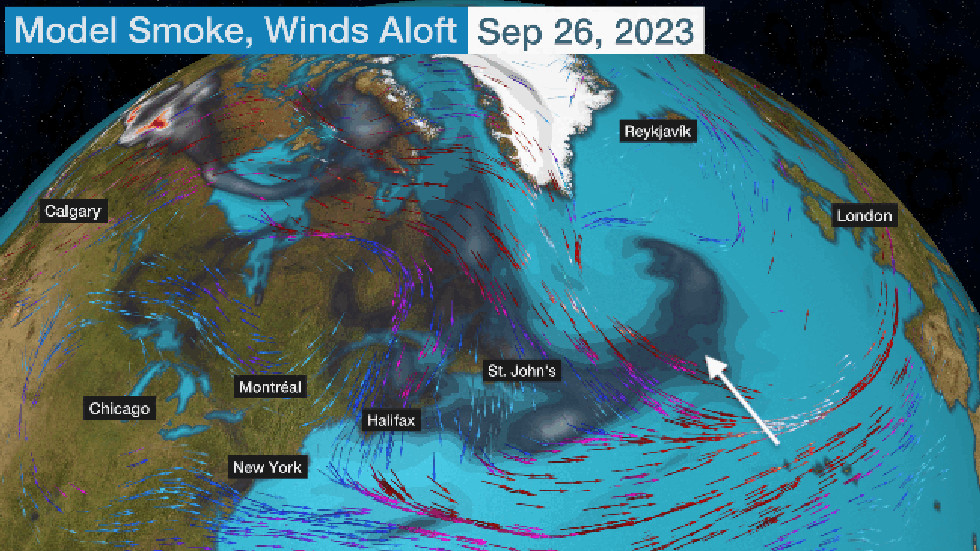Jonathan Erdman
Canadian wildfire smoke has been pulled across the Atlantic Ocean as far east as Ireland, a strange sight for late September during the country's most prolific season of wildfires on record.
Satellite imagery Wednesday seemed to be fairly typical for September over the Atlantic Ocean. A pair of storms - one of which was named Storm Agnes by the U.K. Met Office - were lined up headed for Ireland and the U.K.
However, as the image below showed, there were also plumes of smoke from Canada across the ocean toward Ireland. The smoke was particularly dense over Nova Scotia, New Brunswick, Newfoundland, even parts of Downeast Maine.
 Visible satellite image taken at 12 p.m. EDT on Sept. 27, 2023, showed the plumes of lofted wildfire smoke (shown in brown) extending from the Canadian Maritimes across the Atlantic Ocean headed for Ireland.
Visible satellite image taken at 12 p.m. EDT on Sept. 27, 2023, showed the plumes of lofted wildfire smoke (shown in brown) extending from the Canadian Maritimes across the Atlantic Ocean headed for Ireland.How the smoke got there: A rash of Canadian wildfires starting in late spring continues to burn here in early fall. According to the Canadian Interagency Forest Fire Centre, almost 900 active fires were burning across the country as of Sept. 27. Over half of those were reported as "out of control".
In this case, the upper-level winds tapped this smoke from western and central Canada and pushed it into Atlantic Canada. Then, the jet stream took it from there, whipping plumes of lofted smoke across the Atlantic Ocean, eventually getting intertwined with a couple of Atlantic storms before arriving in Ireland. You can see this in a model plot below.
It's unlikely any of that smoke reached the ground in Ireland or the U.K., and may have been difficult to discern given they were being hit by Storm Agnes winds.
 This forecast model plot shows lofted smoke (in various shades of gray) and upper-level winds transporting the smoke across the Atlantic Ocean from Sept. 26-27, 2023.
This forecast model plot shows lofted smoke (in various shades of gray) and upper-level winds transporting the smoke across the Atlantic Ocean from Sept. 26-27, 2023.How bizarre this is for this time of year: Over the past several months, we've seen periods when more dense wildfire smoke from Canada was pulled into the U.S., particularly in June.
What's strange about this is it's happening near the end of September, when thoughts of wildfire smoke from Canada usually begin to give way toward more potent cold fronts with crisp, clean fall air.
And that's a function of how extreme Canada's wildfires have been.
Fires have burned roughly 69,000 square miles of land in Canada so far this year, an area roughly the size of Missouri and by far the most on record since the early 1980s.
As research scientist Yan Boulanger noted, about one-third of an average full fire season of land in Canada burned in just one day last Saturday.
It remains to be seen how late into fall we'll continue to see wildfire smoke pulled across the Atlantic Ocean or, at times, into parts of the U.S.
Jonathan Erdman is a senior meteorologist at weather.com and has been an incurable weather geek since a tornado narrowly missed his childhood home in Wisconsin at age 7. Follow him on X/Twitter, Facebook and Threads.
The Weather Company’s primary journalistic mission is to report on breaking weather news, the environment and the importance of science to our lives. This story does not necessarily represent the position of our parent company, IBM.
The Weather Company’s primary journalistic mission is to report on breaking weather news, the environment and the importance of science to our lives. This story does not necessarily represent the position of our parent company, IBM.

No comments:
Post a Comment